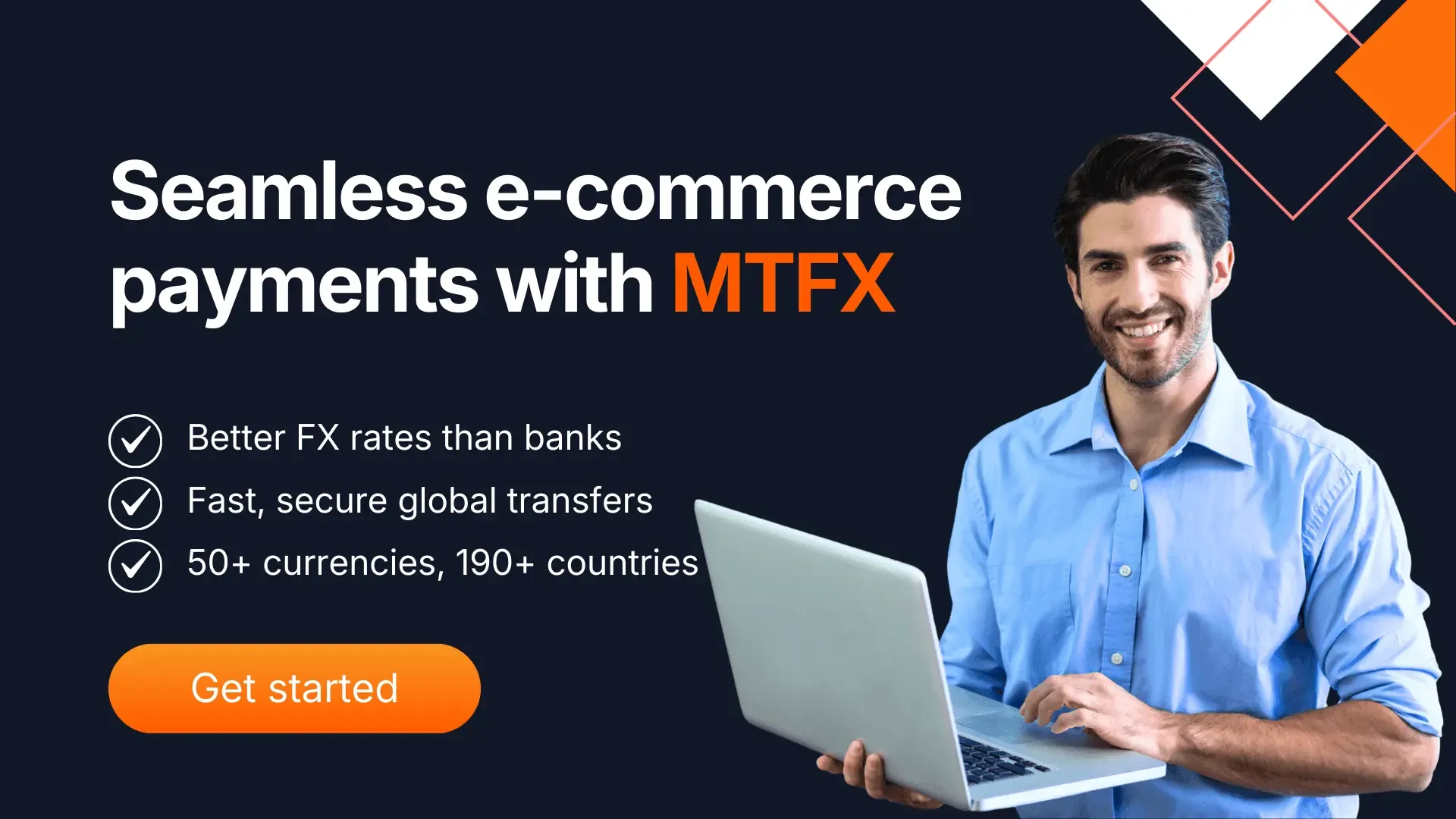E-Commerce Payment Processing: What is it and How Does it Work?
This blog explains how e-commerce payment processing works, from gateways to settlement. It highlights the key components, costs, and risks involved, and shows how Canadian businesses can manage cross-border sales more efficiently. You’ll also learn what to look for when choosing the right e-commerce payment solutions to support growth.
How do online businesses make sure every payment moves smoothly from a customer’s card or digital wallet to their account? The answer lies in e-commerce payment processing, the system that powers every transaction behind the scenes. As digital sales continue to grow worldwide, understanding these processes is now essential for companies of all sizes. For Canadian businesses, competition is rising. The right payment solution helps manage sales, handle cross-border transactions and expand into new markets. This guide explores how payment processing works, the key components involved, and the factors to consider when selecting the best system for your business.
What is e-commerce payment processing?
E-commerce payment processing refers to the digital systems and steps that let online businesses accept payments over the internet. In simple terms, it’s how an online store moves money from a customer’s credit card, bank, or digital wallet into the store’s account once a purchase is made. This involves software and financial networks working together to authenticate the payment and transfer funds securely. According to market forecasts, revenue in the global e-commerce market is projected to reach roughly US$3.66 trillion in 2025. That scale is why businesses need reliable systems to handle e-commerce payments efficiently.
For Canadian businesses, the stakes are even clearer. Revenue is expected to show an annual growth rate (CAGR 2025–2030) of 4.90%, resulting in a projected market volume of US$86.34 billion by 2030. That growth makes e-commerce payments a critical part of capturing both domestic and international sales. A strong payment processing setup helps that customers can pay quickly and securely while businesses receive funds without disruption, making it the backbone of successful online operations worldwide.

How does e-commerce payment processing work?
When a customer completes a purchase online, a series of steps occurs in just a few seconds. Although it appears instant, multiple systems work together behind the scenes to complete the transaction. In short, e-commerce payment processing helps you move money securely from the customer to the merchant.
1- Customer checkout
The process begins when a shopper enters card details or uses a digital wallet. The order amount and payment data are submitted for processing. This is the first step in most e-commerce payment systems, whether in a local store or a global marketplace.
2- Payment gateway
The website’s payment gateway acts like a virtual card terminal. It encrypts sensitive data and sends it to the processor or the acquiring bank. This protects card details and allows safe transmission over the internet. A reliable payment gateway for e-commerce reduces risk and improves trust at checkout.
3- Processor and bank authorization
The processor routes transaction data through card networks (Visa, Mastercard, etc.) to the customer’s issuing bank. The bank checks funds, performs fraud screening, and either approves or declines the transaction. This is one reason cross-border e-commerce payments need strong fraud controls.
4- Transaction confirmation
The processor returns the result to the gateway, which updates the website. Customers see an approved or declined message. If declined, they may try another method, highlighting the importance of offering multiple e-commerce payment methods such as cards, wallets, or bank transfers.
5- Settlement of funds
For approved sales, the acquirer collects the payment and transfers the funds to your business account. At this stage, any e-commerce transaction fees are applied.
Efficient payment flows not only improve customer experience but also support international growth.Businesses that sell globally can simplify their setup by using a provider that supports multi-currency e-commerce payment systems and competitive foreign exchange. For example, MTFX e-commerce solutions make it easier to manage payments across borders, while our global payments services help Canadian companies expand into international markets.
Key components of online payment processing
Several parts work together to make e-commerce payments possible. Understanding these components helps businesses see how the system connects from checkout to settlement.
Payment gateway
The payment gateway is the front-end tool that connects an online store to the payment network. It captures payment details- such as card or digital wallet information - encrypts the data, and passes it securely for authorization. In practice, it works like a virtual card terminal for online business payments. Strong gateways play a vital role in preventing fraud and supporting various payment methods.
Payment processor
The processor is the engine that moves data between banks, card networks, and the merchant. It authorizes transactions, confirms approval or decline, and ensures funds flow to the merchant’s account. A good processor handles thousands of requests in seconds and supports global e-commerce traffic without disruption. For Canadian SMEs, using platforms that support low-cost e-commerce payments can make a real difference in reducing overhead. This is where MTFX's e-commerce solutions stand out by offering reliable e-commerce payment processing, better exchange rates than banks, and transparent pricing.
Merchant account
A merchant account is where approved transactions land before being released into a business’s regular account. It’s a necessary step for handling card payments and e-commerce merchant services. Without it, businesses wouldn’t have a channel to receive online payments. Modern providers often bundle merchant accounts into integrated e-commerce payment solutions, making setup simpler. With MTFX e-commerce payment solutions, transactions are processed directly into your business account, keeping the flow of funds simple. For companies selling internationally, pairing this with an MTFX multi-currency account allows funds to be held in different currencies, reducing conversion costs and supporting scalable e-commerce payment solutions for Canadian SMEs.
By understanding the gateway, processor, and merchant account, businesses can better appreciate how e-commerce payment systems work in practice. Each part has a specific role, but together they ensure smooth, secure, and cost-effective transactions for both merchants and customers.
Security and fraud prevention in e-commerce payments
Keeping transactions safe is essential for building trust with customers and protecting revenue. MTFX helps businesses manage secure and compliant e-commerce payment processing through strategies designed for both local and global sales.
- Secure transactions: Every payment goes through a trusted e-commerce gateway where data stays encrypted and protected from start to finish.
- Cross-border ready systems: MTFX supports cross-border e-commerce payments, helping businesses handle international sales securely.
- Integrated protection: With integrated e-commerce payment solutions, merchants benefit from built-in fraud monitoring and compliance checks without added complexity.
By focusing on security and compliance from the ground up, MTFX ensures businesses can grow online with reliable, safe, and transparent e-commerce payment solutions.
Cross-border and multi-currency payment considerations
One of the biggest advantages of e-commerce is that even small Canadian businesses can sell globally. However, managing cross-border e-commerce payments requires structured planning, as factors such as currency exchange, local payment preferences, and regulatory compliance directly influence how smoothly transactions are completed.
Multi-currency payments
Allowing customers to pay in their own currency removes uncertainty and improves conversion rates. With an MTFX multi-currency account, businesses can hold and manage funds in over 50 currencies, avoiding double conversions and reducing costs. This approach supports both e-commerce payment solutions for Canadian SMEs and larger enterprises.
Foreign exchange risks
Exchange rate fluctuations can impact revenue. Using strategic tools such as rate alerts to manage FX exposure helps stabilize margins. MTFX provides transparent electronic payment processing and risk management to keep cash flow predictable.
Local payment options
Beyond credit cards, some markets rely on wallets or local systems. Flexible gateways help you support popular e-commerce payment methods in Canada and abroad. Businesses adapting to cross-border payment needs can better serve customers by aligning with local preferences and trusted platforms.
Compliance and security
To expand internationally, businesses must comply with tax rules, financial regulations, and data protection standards across regions. Partnering with trusted e-commerce payment processing companies like MTFX helps keep every transaction compliant and secure, reducing risks when operating in multiple markets.
Marketplace integration
Sellers often operate across platforms such as Amazon, eBay, and Shopify, each with different payout processes. Using reliable online payment processing platforms allows businesses to consolidate collections into one system, making global operations more efficient and improving cash flow visibility.

Choosing the right e-commerce payment solution
MTFX emphasizes transparent, bank-beating rates that make platforms supporting low-cost e-commerce payments accessible for businesses of all sizes. The solution you choose should not only handle transactions but also support growth, reduce costs, and simplify global operations. Providers that use mid-market exchange rates with transparent margins, such as MTFX, give businesses clearer visibility on costs and better value, helping them manage international sales with greater clarity.
Fees and transparency
Always review e-commerce transaction fees carefully. Even small differences in rates can impact margins, especially for SMEs. MTFX emphasizes transparent, bank-beating rates that make platforms supporting low-cost e-commerce payments accessible for businesses of all sizes.
Integration and marketplace access
A strong payment system should connect seamlessly with your platform, whether it’s Shopify, WooCommerce, or Amazon. For companies selling on multiple marketplaces, integrated online payment processing platforms make it easier to manage collections. Many Canadian businesses also need to collect US dollar pay-outs from major e-commerce platforms, so choosing the right provider matters for smooth cross-border operations.
Security and compliance
Ensuring security and regulatory compliance is a core requirement for any business handling online transactions. Choosing providers with regulated, compliant e-commerce payment solutions helps safeguard every payment and keeps your operations aligned with both local and international standards.
Speed and reliability
The speed and consistency of payment settlements directly affect a company’s cash flow and day-to-day operations. With efficient electronic payment processing, businesses gain quicker access to funds, reducing delays in paying suppliers or reinvesting in inventory.
Scalability and added services
Beyond payments, look for providers that offer e-commerce merchant services like bulk payouts, risk management, or treasury solutions. MTFX’s ecosystem supports both collections and outgoing transfers, making it easier to manage online business payments as your company grows.
Supported currencies and reach
If you plan to scale internationally, your provider should support multi-currency e-commerce payment systems and have the ability to process transactions across regions. With MTFX, businesses can collect in 50+ currencies in over 190 countries and manage global e-commerce payments without the burden of opening multiple accounts.
Check the live exchange rates below for some of the major currency pairs available through MTFX and see how much you can save when transferring money internationally.
Simplify your e-commerce payments with MTFX
Managing e-commerce payments doesn’t have to be complicated. From supporting multiple currencies to reducing costs and keeping transactions secure, the right partner makes a real difference in how your business grows. MTFX combines transparent pricing, effective e-commerce payment solutions and reliable cross-border capabilities to help businesses handle both local and international sales with ease.
Whether you’re exploring new markets, managing payouts from marketplaces, or streamlining online payment processing for small businesses, MTFX provides the tools and expertise to keep your payment systems efficient and compliant. With the right approach, you can spend less time on payment processing and more on building customer trust and growing your business.
Open an MTFX account to simplify your e-commerce payments with secure, low-cost global processing. Get started today to manage sales, pay-outs and multi-currency transactions in one place.
FAQs
1. What is e-commerce payment processing?
E-commerce payment processing is the system that securely moves money from a customer’s credit card, bank, or digital wallet into a merchant’s account when a purchase is made. It involves gateways, processors, and banks working together in seconds to complete the transaction.
2. How does e-commerce payment processing differ from traditional payments?
Traditional payments rely on physical card readers and manual settlement, while e-commerce payment processing is entirely digital, allowing for faster approvals, multi-currency transactions, and integration with online platforms.
3. What are the most popular e-commerce payment methods in Canada?
Credit and debit cards are still the most commonly used e-commerce payment methods in Canada, while digital wallets like Google Pay are becoming increasingly popular for their speed and convenience. However, for businesses aiming to grow internationally, MTFX stands out as the smarter choice. With its multi-currency e-commerce payment solutions, MTFX enables companies to collect payments in 50+ currencies across 190+ countries, manage transactions efficiently, and benefit from competitive exchange rates - all through one trusted platform.
4. What are e-commerce transaction fees, and why do they matter?
Transaction fees are the charges applied per sale, usually a small percentage plus a flat rate. They matter because even small differences in fees can materially impact margins for businesses with high sales volumes.
5. How do cross-border e-commerce payments work?
Cross-border payments allow businesses to accept money from customers in other countries. They often involve currency conversion, compliance with local regulations, and support for preferred local payment methods.
6. What is the best way to accept e-commerce payments in Canada?
The best approach is to use a platform that supports multiple payment methods, provides transparent fees, and enables multi-currency e-commerce payment systems. Many Canadian SMEs choose MTFX for reliable cross-border payment capabilities.
7. How do online payment processing platforms integrate with marketplaces?
Leading online payment processing platforms integrate directly with sites like Amazon, Shopify, and eBay, allowing businesses to collect payouts in one place. This reduces administrative work and ensures smoother cash flow.
8. How do e-commerce payment solutions help businesses scale globally?
They help merchants handle cross-border transactions, support varied payment methods and manage currency risk effectively. With MTFX, Canadian businesses gain the flexibility to expand into new markets while keeping costs predictable.
Open an account with MTFX today and simplify your e-commerce payments with secure, low-cost global processing. Get started now to manage sales, payouts, and multi-currency transactions all in one place.
Sources:
Related Blogs
Stay ahead with fresh perspectives, expert tips, and inspiring stories.

Keep updated
Make informed decisions
Access tools to help you track, manage, and simplify your global payments.
Currency market updates
Track key currency movements and plan your transfers with confidence.
Create an account today
Start today, and let us take the hassle out of overseas transfers.
